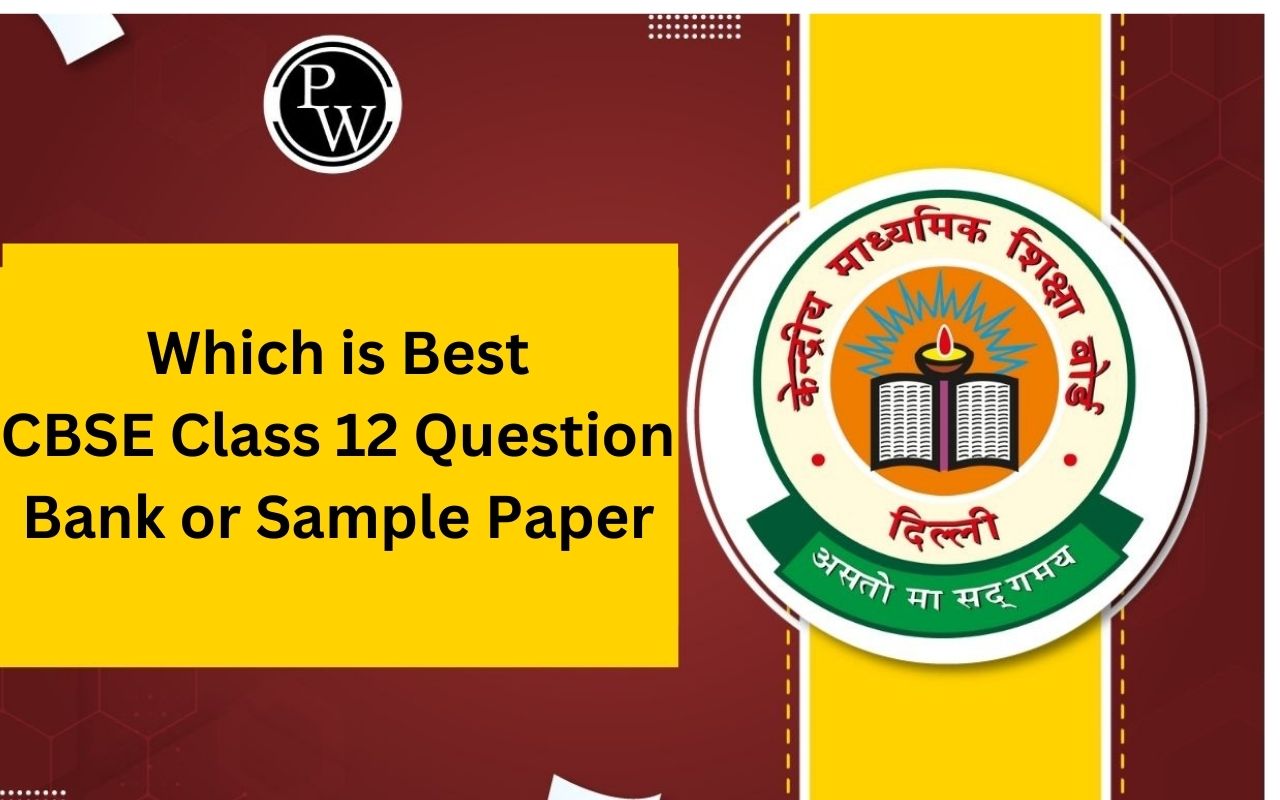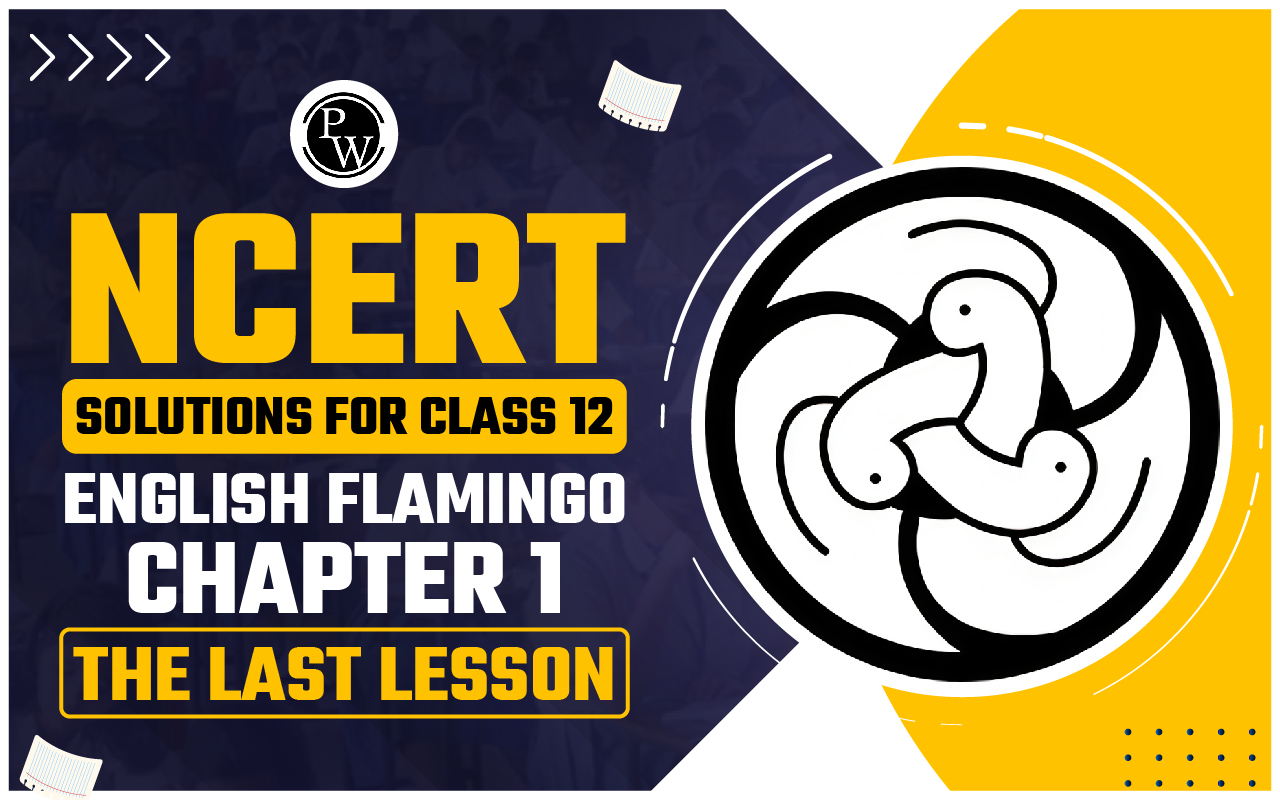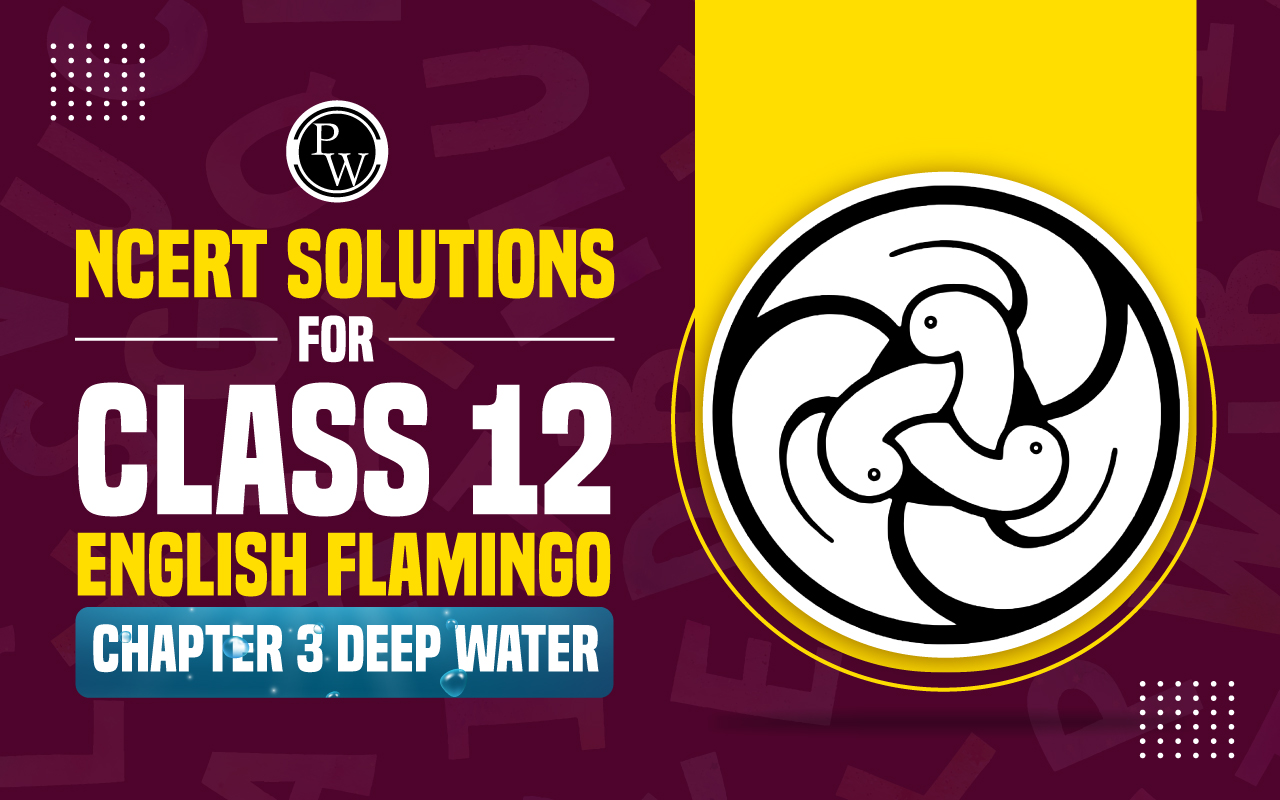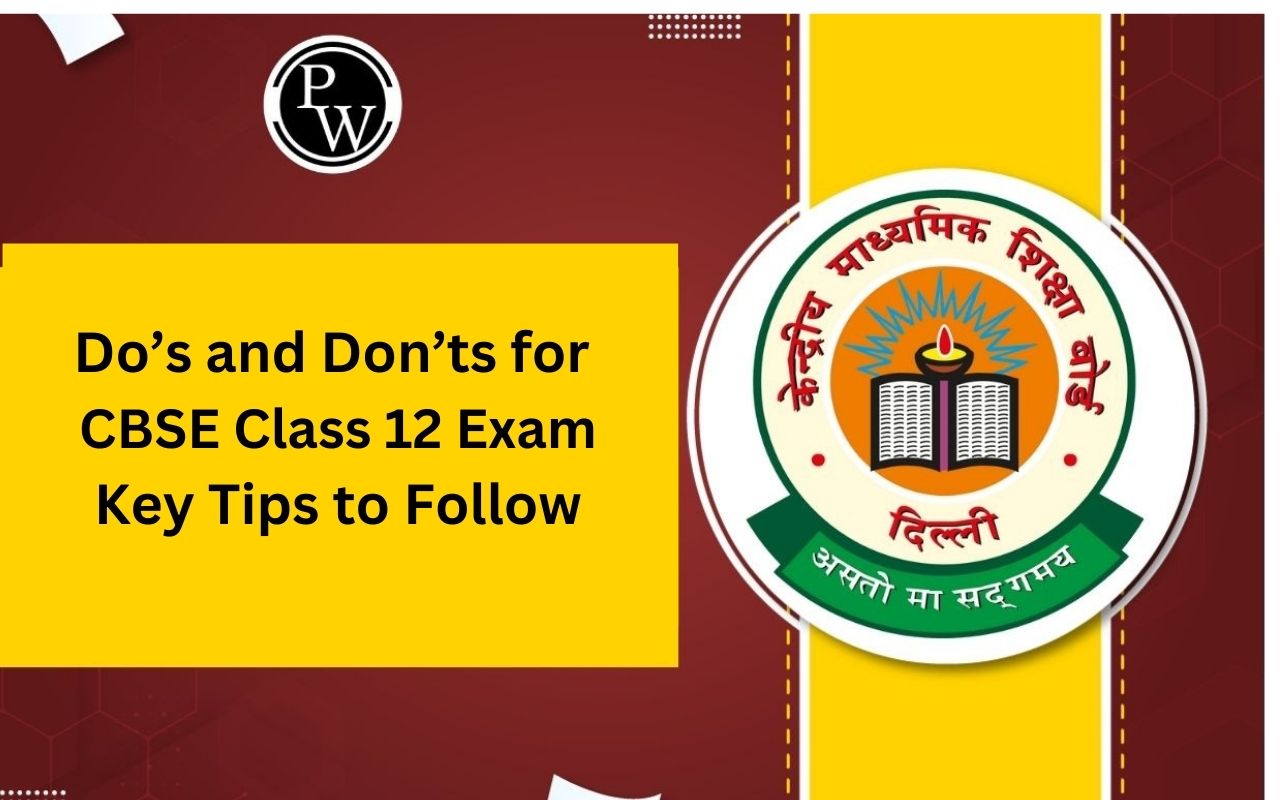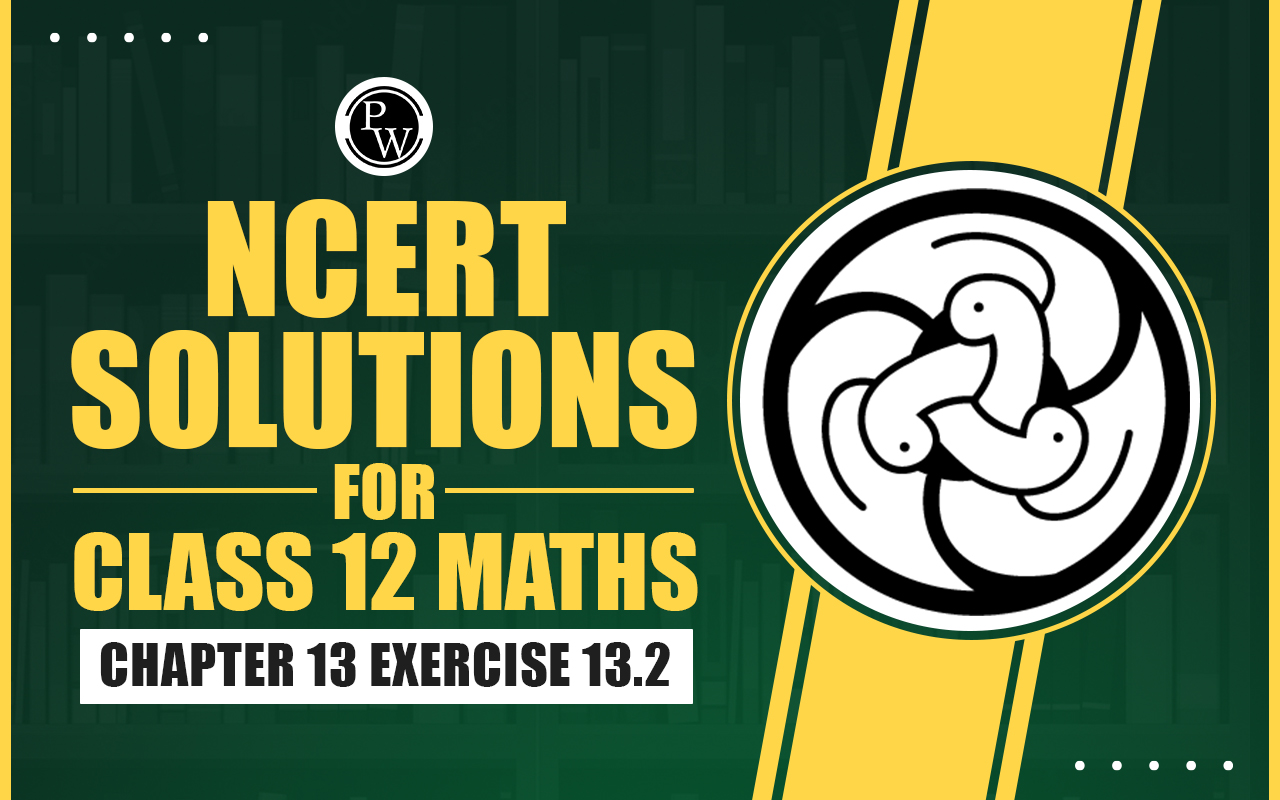
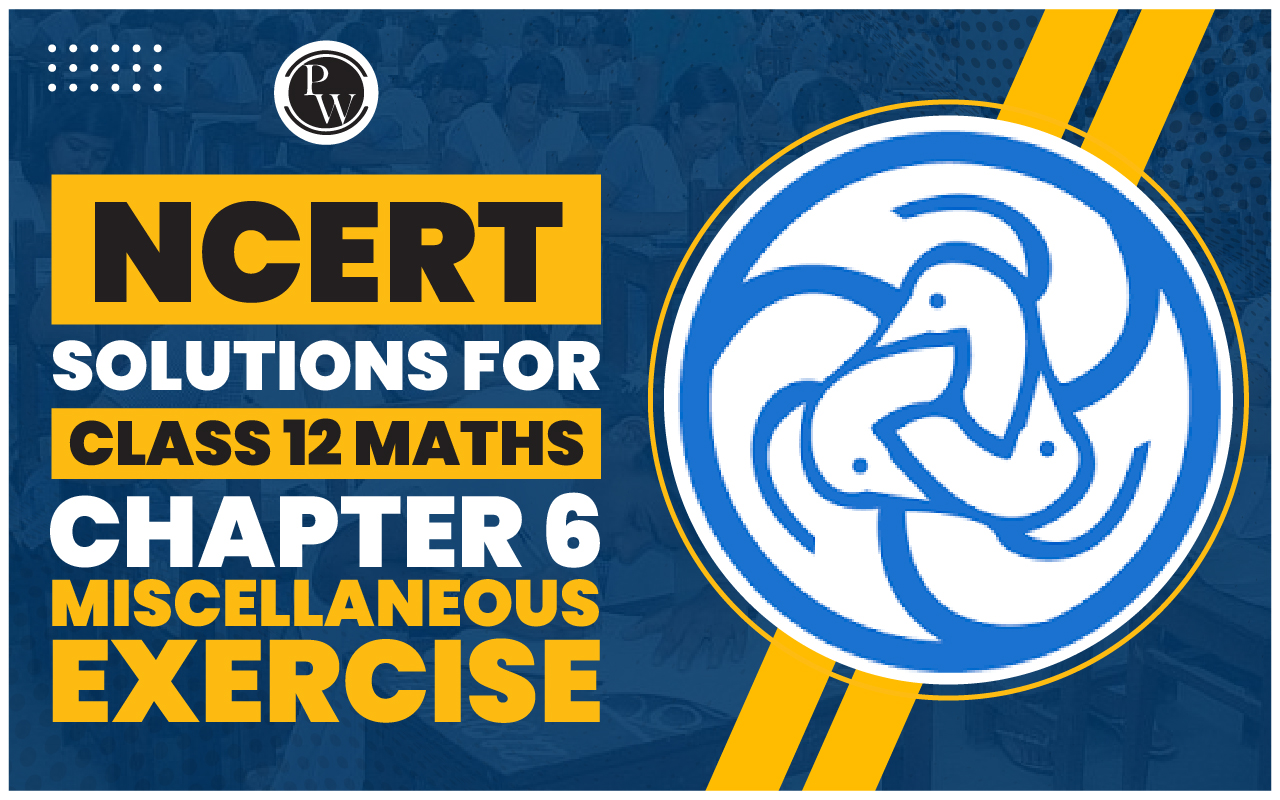
NCERT Solutions for Class 12 Maths Chapter 6 Miscellaneous Exercise
NCERT Solutions for Class 12 Maths Chapter 6 Miscellaneous Exercise Applications of Derivatives is prepared by the academic team of Physics Wallah. We have prepared NCERT Solutions for all exercise of Chapter 6. Given below is step by step solutions of all questions given in the NCERT Solutions for Class 12 Maths Chapter 6 Miscellaneous Exercise.NCERT Solutions for Class 12 Maths Chapter 6 Miscellaneous Exercise Overview
NCERT Solutions for Class 12 Maths Chapter 6 Miscellaneous Exercise is prepared by our experts to help students understand the concepts of the chapter better. Students can solve these questions before their examinations these questions will help them to understand the concepts better and by doing these questions students can easily ace their examinations.NCERT Solutions for Class 12 Maths Chapter 6 Miscellaneous Exercise
Solve The Following Questions NCERT Solutions for Class 12 Maths Chapter 6 Miscellaneous Exercise
Question 1. Using differentials, find the approximate value of each of the following: (a) (17/81) 1/4 (b) (33) 1/5 Solution :
 = 0.497
= 0.497
NCERT Solutions for Class 12 Maths Chapter 6 Exercise 6.1
Question 2. Show that the function given by f(x) = logx / x has maximum value at x = e Solution :
NCERT Solutions for Class 12 Maths Chapter 6 Exercise 6.2
Question 3. The two equal sides of an isosceles triangle with fixed base b are decreasing at the rate of 3 cm per second. How fast is the area decreasing when the two equal sides are equal to the base? Solution : Let ΔABC be isosceles where BC is the base of fixed length b . Let the length of the two equal sides of ΔABC be a . Draw AD⊥BC. Therefore, the area is decreasing at the rate of √3b cm
2
/s.
Therefore, the area is decreasing at the rate of √3b cm
2
/s.
NCERT Solutions for Class 12 Maths Chapter 6 Exercise 6.3
Question 4. Find the equation of the normal to the curve y 2 = 4 x at the point (1, 2). Solution : Equation of the curve is y 2 = 4 x ……….(i)
NCERT Solutions for Class 12 Maths Chapter 6 Exercise 6.4
Question 5. Show that the normal at any point θ to the curve x = a cosθ + a θ sin θ, y = a sin θ - aθ cos θ is at a constant distance from the origin. Solution : We have x = a cos θ + a θ sin θ . Hence, the perpendicular distance of the normal from the origin is constant.
Hence, the perpendicular distance of the normal from the origin is constant.
NCERT Solutions for Class 12 Maths Chapter 6 Exercise 6.5
Question 6. Find the intervals in which the function f given by is (i) increasing (ii) decreasing.
Solution :
is (i) increasing (ii) decreasing.
Solution :
 Question
7. Find the intervals in which the function f given by
Question
7. Find the intervals in which the function f given by
 is (i) increasing (ii) decreasing.
Solution :
is (i) increasing (ii) decreasing.
Solution :
 Question
8. Find the maximum area of an isosceles triangle inscribed in the ellipse
Question
8. Find the maximum area of an isosceles triangle inscribed in the ellipse
 with its vertex at one end of the major axis.
Solution :
Equation of the ellipse is
with its vertex at one end of the major axis.
Solution :
Equation of the ellipse is

 Let the major axis be along the
x
−axis.
Let ABC be the triangle inscribed in the ellipse where vertex C is at (
a
, 0).
Since the ellipse is symmetrical with respect to the
x
−axis and
y
−axis, we can assume the coordinates of A to be (−
x
1
,
y
1
) and the coordinates of B to be (−
x
1
, −
y
1
).
Let the major axis be along the
x
−axis.
Let ABC be the triangle inscribed in the ellipse where vertex C is at (
a
, 0).
Since the ellipse is symmetrical with respect to the
x
−axis and
y
−axis, we can assume the coordinates of A to be (−
x
1
,
y
1
) and the coordinates of B to be (−
x
1
, −
y
1
).


 Question 9. A tank with rectangular base and rectangular sides, open at the top is to be constructed so that its depth is 2 m and volume is 8 m3. If building of tank costs ` 70 per sq. meter for the base and ` 45 per square meter for sides. What is the cost of least expensive tank?
Solution :
Given: Depth of tank = 2 m
Let
l
,
b
, and
h
represent the length, breadth, and height of the tank respectively.
Then, we have height (
h)
= 2 m
Volume of the tank = 8m
3
Volume of the tank =
l
×
b
×
h
∴ 8 =
l
×
b
× 2
lb = 4, b = 4/l
Now, area of the base =
lb
= 4
Area of the 4 walls (
A)
= 2
h
(
l
+
b)
Question 9. A tank with rectangular base and rectangular sides, open at the top is to be constructed so that its depth is 2 m and volume is 8 m3. If building of tank costs ` 70 per sq. meter for the base and ` 45 per square meter for sides. What is the cost of least expensive tank?
Solution :
Given: Depth of tank = 2 m
Let
l
,
b
, and
h
represent the length, breadth, and height of the tank respectively.
Then, we have height (
h)
= 2 m
Volume of the tank = 8m
3
Volume of the tank =
l
×
b
×
h
∴ 8 =
l
×
b
× 2
lb = 4, b = 4/l
Now, area of the base =
lb
= 4
Area of the 4 walls (
A)
= 2
h
(
l
+
b)
 Thus, by second derivative test, the area is the minimum when
l
= 2.
We have
l
=
b
=
h
= 2.
∴Cost of building the base = Rs 70 × (
lb
) = Rs 70 (4) = Rs 280
Cost of building the walls = Rs 2
h
(
l
+
b
) × 45 = Rs 90 (2) (2 + 2)
= Rs 8 (90) = Rs 720
Required total cost = Rs (280 + 720) = Rs 1000
Hence, the total cost of the tank will be Rs 1000.
Question
10. The sum of the perimeter of a circle and square is k where k is some constant. Prove that the sum of their areas is least when the side of square is double the radius of the circle.
Solution :
Let r be the radius of the circle and a be the side of square.
Thus, by second derivative test, the area is the minimum when
l
= 2.
We have
l
=
b
=
h
= 2.
∴Cost of building the base = Rs 70 × (
lb
) = Rs 70 (4) = Rs 280
Cost of building the walls = Rs 2
h
(
l
+
b
) × 45 = Rs 90 (2) (2 + 2)
= Rs 8 (90) = Rs 720
Required total cost = Rs (280 + 720) = Rs 1000
Hence, the total cost of the tank will be Rs 1000.
Question
10. The sum of the perimeter of a circle and square is k where k is some constant. Prove that the sum of their areas is least when the side of square is double the radius of the circle.
Solution :
Let r be the radius of the circle and a be the side of square.
 Therefore, sum of areas is minimum when side of the square is double the radius of the circle.
Question
11. A window is in the form of a rectangle surmounted by a semicircular opening. The total perimeter of the window is 10 m. Find the dimensions of the window to admit maximum light through the whole opening.
Solution :
Let
x
and
y
be the length and breadth of the rectangular window.
Radius of the semicircular opening = x/2
Therefore, sum of areas is minimum when side of the square is double the radius of the circle.
Question
11. A window is in the form of a rectangle surmounted by a semicircular opening. The total perimeter of the window is 10 m. Find the dimensions of the window to admit maximum light through the whole opening.
Solution :
Let
x
and
y
be the length and breadth of the rectangular window.
Radius of the semicircular opening = x/2
 It is given that the perimeter of the window is 10 m.
It is given that the perimeter of the window is 10 m.
 ∴Area of the window (
A)
is given by,
∴Area of the window (
A)
is given by,
 Thus, when
Thus, when
 Therefore, by second derivative test, the area is the maximum when length x = 20/π + 4m.
Therefore, by second derivative test, the area is the maximum when length x = 20/π + 4m.
 Hence, the required dimensions of the window to admit maximum light is given bylength = 20/π+4m and breadth = 10/π+4m.
Question
12. A point on the hypotenuse of a triangle is at distances a and b from the sides of the triangle. Show that the maximum length of the hypotenuse is
Hence, the required dimensions of the window to admit maximum light is given bylength = 20/π+4m and breadth = 10/π+4m.
Question
12. A point on the hypotenuse of a triangle is at distances a and b from the sides of the triangle. Show that the maximum length of the hypotenuse is
 Solution :
Let ΔABC be right-angled at B. Let AB =
x
and BC =
y
.
Let P be a point on the hypotenuse of the triangle such that P is at a distance of
a
and
b
from the sides AB and BC respectively.
Let ∠C =
θ
.
Solution :
Let ΔABC be right-angled at B. Let AB =
x
and BC =
y
.
Let P be a point on the hypotenuse of the triangle such that P is at a distance of
a
and
b
from the sides AB and BC respectively.
Let ∠C =
θ
.
 We have,
AC = √x
2
+ y
2
Now,
PC =
b
cosec
θ
And, AP =
a
sec
θ
∴AC = AP + PC
⇒ AC =
b
cosec
θ
+
a
sec
θ
… (1)
We have,
AC = √x
2
+ y
2
Now,
PC =
b
cosec
θ
And, AP =
a
sec
θ
∴AC = AP + PC
⇒ AC =
b
cosec
θ
+
a
sec
θ
… (1)
 Therefore, by second derivative test, the length of the hypotenuse is the maximum when tan θ(b/a)
1/3
Now, when tan θ(b/a)
1/3
, we have:
Therefore, by second derivative test, the length of the hypotenuse is the maximum when tan θ(b/a)
1/3
Now, when tan θ(b/a)
1/3
, we have:
 Hence, the maximum length of the hypotenuses is
Hence, the maximum length of the hypotenuses is
 Question
13. Find the points at which the function f given by f(x) = (x - 2)
4
(x + 1)
3
has:
(i) local maxima
(ii) local minima
(iii) point of inflexion.
Solution :
Given: f(x) = (x - 2)
4
(x + 1)
3
Question
13. Find the points at which the function f given by f(x) = (x - 2)
4
(x + 1)
3
has:
(i) local maxima
(ii) local minima
(iii) point of inflexion.
Solution :
Given: f(x) = (x - 2)
4
(x + 1)
3
 Now, for values of
x
close to 2/7 and to the left of 2/7, f'(x) > 0. Also, for values of
x
close to 2/7 and to the right of 2/7, f'(x) < 0
Thus, x = 2/7 is the point of local maxima.
Now, for values of
x
close to 2 and to the left of 2, f'(x) < 0 Also, for values of
x
close to 2 and to the right of 2, f'(x) > 0
Thus,
x
= 2 is the point of local minima.
Now, as the value of
x
varies through −1,f'(x) does not changes its sign.
Thus,
x
= −1 is the point of inflexion.
Question
14. Find the absolute maximum and minimum values of the function f given by f(x) = cos
2
x + sin x , x ∊ [0,π ]
Solution :
Given:f(x) = cos
2
x + sin x ……….(i)
Now, for values of
x
close to 2/7 and to the left of 2/7, f'(x) > 0. Also, for values of
x
close to 2/7 and to the right of 2/7, f'(x) < 0
Thus, x = 2/7 is the point of local maxima.
Now, for values of
x
close to 2 and to the left of 2, f'(x) < 0 Also, for values of
x
close to 2 and to the right of 2, f'(x) > 0
Thus,
x
= 2 is the point of local minima.
Now, as the value of
x
varies through −1,f'(x) does not changes its sign.
Thus,
x
= −1 is the point of inflexion.
Question
14. Find the absolute maximum and minimum values of the function f given by f(x) = cos
2
x + sin x , x ∊ [0,π ]
Solution :
Given:f(x) = cos
2
x + sin x ……….(i)
 Now, evaluating the value of
f
at critical points x = π/2 and x = π/6 and at the end points of the interval [0,π ] (i.e., at
x
= 0 and
x
= π), we have:
Now, evaluating the value of
f
at critical points x = π/2 and x = π/6 and at the end points of the interval [0,π ] (i.e., at
x
= 0 and
x
= π), we have:
 Hence, the absolute maximum value of
f
is 5/4 occurring at x = π/6 and the absolute minimum value of
f
is 1 occurring at x = 0, π/2, and π.
Question
15. Show that the altitude of the right circular cone of maximum volume that can be inscribed in a sphere of radius r is 4r/3
Solution :
Let r be the radius of base of cone and h be the height of the cone inscribed in a sphere of radius
Hence, the absolute maximum value of
f
is 5/4 occurring at x = π/6 and the absolute minimum value of
f
is 1 occurring at x = 0, π/2, and π.
Question
15. Show that the altitude of the right circular cone of maximum volume that can be inscribed in a sphere of radius r is 4r/3
Solution :
Let r be the radius of base of cone and h be the height of the cone inscribed in a sphere of radius
 The volume (
V)
of the cone is given by,
V = 1/3πR
2
h
Now, from the right triangle BCD, we have:
BC = √r
2
- R
2
∴
h
= r+√r
2
- R
2
The volume (
V)
of the cone is given by,
V = 1/3πR
2
h
Now, from the right triangle BCD, we have:
BC = √r
2
- R
2
∴
h
= r+√r
2
- R
2

 Hence, it can be seen that the altitude of the right circular cone of maximum volume that can be inscribed in a sphere of radius
r
is 4r/3.
Question
16. Let
f
be a function defined on [
a
,
b
] such that
f
'(
x
) > 0, for all
x
∈ (
a
,
b
). Then prove that
f
is an increasing function on (
a
,
b
).
Solution :
Let x1, x2∈(a,b) such that x1<x2.
Consider the sub-interval [x1, x2]. Since f(x) is differentiable on (a, b) and [x1, x2]⊂(a,b).
Therefore, f(x) is continous on [x1, x2] and differentiable on (x1, x2).
By the Lagrange's mean value theorm, there exists c∈(x1, x2) such that
f'(c)=f(x2)-f(x1)x2-x1 ...(1)
Since f'(x) ) > 0 for all x∈(a,b), so in particular, f'(c) > 0.
f'(c)>0⇒f(x2)-f(x1)x2-x1>0 [Using (1)]
⇒f(x2)-f(x1)>0 [∵ x2-x1>0 when x1<x2]
⇒f(x2)>f(x1)⇒f(x1)<f(x2)
Since x1, x2 are arbitrary points in (a,b).
Therefore, x1<x2⇒f(x1)<f(x2) for all x1,x2∈(a, b)
Hence,f(x) is increasing on (a,b).
Question
17. Show that the height of the cylinder of maximum volume that can be inscribed in a sphere of radius R is 2R/√3 Also find the maximum volume.
Solution :
A sphere of fixed radius (
R)
is given.
Let
r
and
h
be the radius and the height of the cylinder respectively.
Hence, it can be seen that the altitude of the right circular cone of maximum volume that can be inscribed in a sphere of radius
r
is 4r/3.
Question
16. Let
f
be a function defined on [
a
,
b
] such that
f
'(
x
) > 0, for all
x
∈ (
a
,
b
). Then prove that
f
is an increasing function on (
a
,
b
).
Solution :
Let x1, x2∈(a,b) such that x1<x2.
Consider the sub-interval [x1, x2]. Since f(x) is differentiable on (a, b) and [x1, x2]⊂(a,b).
Therefore, f(x) is continous on [x1, x2] and differentiable on (x1, x2).
By the Lagrange's mean value theorm, there exists c∈(x1, x2) such that
f'(c)=f(x2)-f(x1)x2-x1 ...(1)
Since f'(x) ) > 0 for all x∈(a,b), so in particular, f'(c) > 0.
f'(c)>0⇒f(x2)-f(x1)x2-x1>0 [Using (1)]
⇒f(x2)-f(x1)>0 [∵ x2-x1>0 when x1<x2]
⇒f(x2)>f(x1)⇒f(x1)<f(x2)
Since x1, x2 are arbitrary points in (a,b).
Therefore, x1<x2⇒f(x1)<f(x2) for all x1,x2∈(a, b)
Hence,f(x) is increasing on (a,b).
Question
17. Show that the height of the cylinder of maximum volume that can be inscribed in a sphere of radius R is 2R/√3 Also find the maximum volume.
Solution :
A sphere of fixed radius (
R)
is given.
Let
r
and
h
be the radius and the height of the cylinder respectively.
 From the given figure, we have h = 2√R
2
- r
2
The volume (
V)
of the cylinder is given by,
From the given figure, we have h = 2√R
2
- r
2
The volume (
V)
of the cylinder is given by,
 Now, it can be observed that at
Now, it can be observed that at
 ∴The volume is the maximum when r
2
= 2R
2
/3
When r
2
= 2R
2
/3, the height of the cylinder is
∴The volume is the maximum when r
2
= 2R
2
/3
When r
2
= 2R
2
/3, the height of the cylinder is
 Hence, the volume of the cylinder is the maximum when the height of the cylinder is
2R/√3
Question
18. Show that the height of the cylinder of greatest volume which can be inscribed in a right circular cone of height h and having semi-vertical angle
α
is one-third that of the cone and the greatest volume of the cylinder is 4/27πh
3
tan2
α
.
Solution :
The given right circular cone of fixed height (
h)
and semi-vertical angle (
α
)
can be drawn as:
Hence, the volume of the cylinder is the maximum when the height of the cylinder is
2R/√3
Question
18. Show that the height of the cylinder of greatest volume which can be inscribed in a right circular cone of height h and having semi-vertical angle
α
is one-third that of the cone and the greatest volume of the cylinder is 4/27πh
3
tan2
α
.
Solution :
The given right circular cone of fixed height (
h)
and semi-vertical angle (
α
)
can be drawn as:
 Here, a cylinder of radius
R
and height
H
is inscribed in the cone.
Then, ∠GAO =
α
, OG =
r
, OA =
h
, OE =
R
, and CE =
H
.
We have,
r
=
h
tan
α
Now, since ΔAOG is similar to ΔCEG, we have:
Here, a cylinder of radius
R
and height
H
is inscribed in the cone.
Then, ∠GAO =
α
, OG =
r
, OA =
h
, OE =
R
, and CE =
H
.
We have,
r
=
h
tan
α
Now, since ΔAOG is similar to ΔCEG, we have:
 Now, the volume (
V)
of the cylinder is given by,
Now, the volume (
V)
of the cylinder is given by,

 ∴By second derivative test, the volume of the cylinder is the greatest when
∴By second derivative test, the volume of the cylinder is the greatest when
 Thus, the height of the cylinder is one-third the height of the cone when the volume of the cylinder is the greatest.
Now, the maximum volume of the cylinder can be obtained as:
Thus, the height of the cylinder is one-third the height of the cone when the volume of the cylinder is the greatest.
Now, the maximum volume of the cylinder can be obtained as:
 Choose the correct answer in the Exercises 19 to 24:
Question
19. A cylindrical tank of radius 10 m is being filled with wheat at the rate of 314 cubic meter per hour. Then the depth of wheat is increasing at the rate of:
(A) 1 m/h
(B) 0.1 m/h
(C) 1.1 m/h
(D) 0.5 m/h
Solution :
Let
r
be the radius of the cylinder.
Then, volume (
V)
of the cylinder is given by,
Choose the correct answer in the Exercises 19 to 24:
Question
19. A cylindrical tank of radius 10 m is being filled with wheat at the rate of 314 cubic meter per hour. Then the depth of wheat is increasing at the rate of:
(A) 1 m/h
(B) 0.1 m/h
(C) 1.1 m/h
(D) 0.5 m/h
Solution :
Let
r
be the radius of the cylinder.
Then, volume (
V)
of the cylinder is given by,
 Differentiating with respect to time
t
, we have:
Differentiating with respect to time
t
, we have:
 The tank is being filled with wheat at the rate of 314 cubic metres per hour.
The tank is being filled with wheat at the rate of 314 cubic metres per hour.
 Thus, we have:
Thus, we have:
 Hence, the depth of wheat is increasing at the rate of 1 m/h.
The correct answer is A.
Question
20. The slope of the tangent to the curve x = t
2
+ 3t – 8, y = 2t
2
– 2t – 5 at the point (2,– 1) is
(A) 22/7
(B) 6/7
(C) 7/6
(D) -6/7
Solution :
The given curve is x = t
2
+ 3t – 8 and y = 2t
2
– 2t – 5
Hence, the depth of wheat is increasing at the rate of 1 m/h.
The correct answer is A.
Question
20. The slope of the tangent to the curve x = t
2
+ 3t – 8, y = 2t
2
– 2t – 5 at the point (2,– 1) is
(A) 22/7
(B) 6/7
(C) 7/6
(D) -6/7
Solution :
The given curve is x = t
2
+ 3t – 8 and y = 2t
2
– 2t – 5
 The given point is (2, −1).
At
x
= 2, we have:
The given point is (2, −1).
At
x
= 2, we have:
 The common value of
t
is 2.
Hence, the slope of the tangent to the given curve at point (2, −1) is
The common value of
t
is 2.
Hence, the slope of the tangent to the given curve at point (2, −1) is
 Therefore, option (B) is correct.
Question
21.
The line
y
=
mx
+ 1 is a tangent to the curve
y
2
= 4
x
if the value of
m
is
(A) 1
(B) 2
(C) 3
(D) 1/2
Solution :
The equation of the tangent to the given curve is
y
=
mx
+ 1.
Now, substituting
y
=
mx
+ 1 in
y
2
= 4
x
, we get:
Therefore, option (B) is correct.
Question
21.
The line
y
=
mx
+ 1 is a tangent to the curve
y
2
= 4
x
if the value of
m
is
(A) 1
(B) 2
(C) 3
(D) 1/2
Solution :
The equation of the tangent to the given curve is
y
=
mx
+ 1.
Now, substituting
y
=
mx
+ 1 in
y
2
= 4
x
, we get:
 Since a tangent touches the curve at one point, the roots of equation (i) must be equal.
Therefore, we have:
Discriminant = 0
Since a tangent touches the curve at one point, the roots of equation (i) must be equal.
Therefore, we have:
Discriminant = 0
 Hence, the required value of
m
is 1.
Therefore, option (A) is correct.
Question
22.
The normal at the point (1, 1) on the curve 2
y
+
x
2
= 3 is
Hence, the required value of
m
is 1.
Therefore, option (A) is correct.
Question
22.
The normal at the point (1, 1) on the curve 2
y
+
x
2
= 3 is
(A) x + y = 0
(B) x − y = 0
(C) x + y + 1 = 0
(D) x − y = 1
Solution : The equation of the given curve is 2 y + x 2 = 3. Differentiating with respect to x , we have: The slope of the normal to the given curve at point (1, 1) is
The slope of the normal to the given curve at point (1, 1) is
 Hence, the equation of the normal to the given curve at (1, 1) is given as:
⇒ y - 1 = 1(x - 1)
⇒ y - 1 = x - 1
⇒ x - y = 0
Therefore, option (B) is correct.
Question
23.
The normal to the curve
x
2
= 4
y
passing (1, 2) is
Hence, the equation of the normal to the given curve at (1, 1) is given as:
⇒ y - 1 = 1(x - 1)
⇒ y - 1 = x - 1
⇒ x - y = 0
Therefore, option (B) is correct.
Question
23.
The normal to the curve
x
2
= 4
y
passing (1, 2) is
(A) x + y = 3
(B) x − y = 3
(C) x + y = 1
(D) x − y = 1
Solution : The equation of the given curve is x 2 = 4 y . Differentiating with respect to x , we have: The slope of the normal to the given curve at point (
h
,
k
) is given by,
The slope of the normal to the given curve at point (
h
,
k
) is given by,
 ∴Equation of the normal at point (
h
,
k
) is given as:
∴Equation of the normal at point (
h
,
k
) is given as:
 Now, it is given that the normal passes through the point (1, 2).
Therefore, we have:
Now, it is given that the normal passes through the point (1, 2).
Therefore, we have:
 Since (
h
,
k
) lies on the curve
x
2
= 4
y
, we have
h
2
= 4
k.
⇒ k =h
2
/4
From equation (i), we have:
Since (
h
,
k
) lies on the curve
x
2
= 4
y
, we have
h
2
= 4
k.
⇒ k =h
2
/4
From equation (i), we have:
 Hence, the equation of the normal is given as:
Hence, the equation of the normal is given as:
 Therefore, option (A) is correct.
Question
24. The points on the curve 9
y
2
=
x
3
where the normal to the curve make equal intercepts with axes are:
Therefore, option (A) is correct.
Question
24. The points on the curve 9
y
2
=
x
3
where the normal to the curve make equal intercepts with axes are:
 Solution :
The equation of the given curve is 9
y
2
=
x
3
.
Differentiating with respect to
x
, we have:
Solution :
The equation of the given curve is 9
y
2
=
x
3
.
Differentiating with respect to
x
, we have:
 The slope of the normal to the given curve at point (x
1
,y
1
) is
The slope of the normal to the given curve at point (x
1
,y
1
) is
 ∴ The equation of the normal to the curve at (x
1
,y
1
) is
∴ The equation of the normal to the curve at (x
1
,y
1
) is
 It is given that the normal makes equal intercepts with the axes.
Therefore, We have:
It is given that the normal makes equal intercepts with the axes.
Therefore, We have:
 Also, the point(x
1
,y
1
)lies on the curve, so we have
9y
1
2
= x
1
3
.....................(ii)
From (i) and (ii), we have:
Also, the point(x
1
,y
1
)lies on the curve, so we have
9y
1
2
= x
1
3
.....................(ii)
From (i) and (ii), we have:
 Therefore, option (A) is correct.
Therefore, option (A) is correct.
NCERT Solutions for Class 12 Maths Chapter 6 Miscellaneous Exercise FAQs
Are miscellaneous questions important for class 12 maths?
Is miscellaneous exercise important for class 12 board 2024?
How many exercises are there in Chapter 6 Maths Class 12?
Which chapter is required for application of derivatives?
Why do we use derivatives in math?




